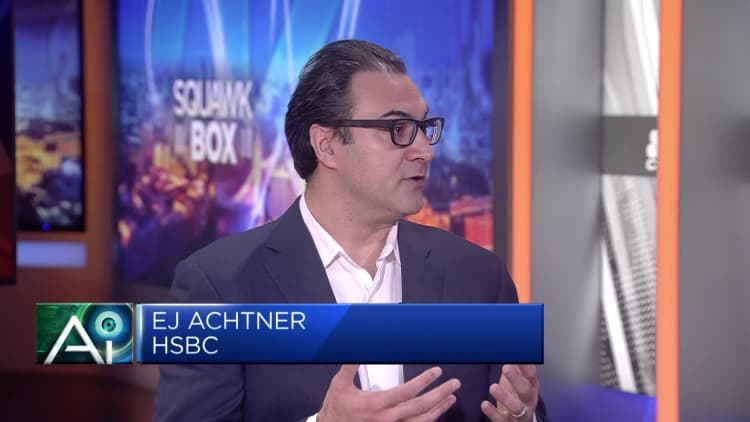
Baidu CEO Robin Li speaks at the company’s Create conference in Shenzhen, China, April 16, 2024.
Bloomberg | Bloomberg | Getty Images
Shenzhen, China—First anniversary of Chinese search engine operator Baidu The company, which launched the ChatGPT-like Ernie bot, this week released tools to encourage locals to develop artificial intelligence applications.
On Tuesday, Baidu CEO Robin Li said in his opening remarks at Baidu’s annual Artificial Intelligence Developer Conference: “Today, China has 1 billion Internet users, powerful basic models, sufficient artificial intelligence application scenarios and the world’s most complete industrial system.
“Everyone can become a developer,” he said in Mandarin, according to a CNBC translation.
While many people point out that China lags behind the United States in terms of artificial intelligence capabilities, others emphasize that the advantage of the Chinese market lies more in technological applications. Take next-day e-commerce and 30-minute food delivery as examples.
Baidu’s new AI tool lets people with no coding knowledge create generative AI chatbots with specific functionality, which can then be integrated into websites, Baidu search engine results or other online portals. This is different from a similar tool called GPT that OpenAI launched earlier this year, because those customized chatbots (which do everything from suggesting videos to fixing code) live in the ChatGPT interface.

Baidu’s basic tools are generally available for free trial until there are certain usage restrictions, similar to Google’s Cloud and AI capabilities. OpenAI charges a monthly fee for the latest version of ChatGPT and the ability to use it with computer programs. The older ChatGPT 3.5 model is free to use, but custom GPTs cannot be accessed.
Baidu this week also announced three new versions of its Ernie AI model — called “Speed,” “Lite” and “Tiny” — that coders can selectively access based on the complexity of the task.
“It feels like their focus is to establish the entire native artificial intelligence development ecosystem and provide a full set of development tools and platform solutions,” said Du Bo, managing director of Huashan Capital. That’s according to CNBC’s translation of China’s remarks.
Baidu said this week that Ernie bot has accumulated more than 200 million users since its launch in March last year, and the computer program accesses the underlying artificial intelligence model 200 million times a day. The company said that more than 85,000 enterprise customers have created 190,000 AI applications using its AI cloud platform.
How the technology is used
Many of the use cases Baidu showcased this week focused on consumer-facing apps: travel and the creation of content such as picture books and scheduling meetings.
In a demo room, Baidu business units showed how AI tools could be integrated with virtual humans conducting live broadcasts or direct search engine traffic to interactive AI-based buying guides.
Buysmart.AI, which won Baidu’s artificial intelligence competition last year, uses the technology in an online shopping assistant connected to Chinese social media platform Weibo.The startup says it is using ChatGPT as a standalone interactive e-commerce app in the United States
“I personally think Ernie 4.0 is better at understanding Chinese than ChatGPT 3.5,” Buysmart.AI co-founder Andy Qiu said in an interview. That’s according to CNBC’s translation of his Mandarin remarks.
Qiu said that American consumers are currently more interested in artificial intelligence products than Chinese users. But overall, he said, there is still room for improvement in building consumer trust in AI assistants and convincing users to place orders.
Also on display is a humanoid robot developed by Shenzhen Ubico Robotics, which uses Baidu’s Ernie AI model to understand instructions and read and write text.
It’s unclear how such AI applications will significantly change business. But Baidu has recently launched more tools to make it easier and cheaper for people to experiment.
Helen Chai, managing director of CIC Consulting, pointed out that customer service, voice assistants and Internet-connected devices can use smaller artificial intelligence models to respond to users quickly.
She added that in scenarios such as legal consultation or medical diagnosis, small AI models can be trained on specific data to achieve performance comparable to large AI models.
Baidu CEO Li said that future large-scale applications based on artificial intelligence will be based on hybrid models, using the technical term “mix of experts” or MoE.
He also touted Baidu’s ability to generate code with artificial intelligence, which the Silicon Valley technology company sees as one of the areas with the greatest potential for generating artificial intelligence.
Baidu said that since deploying its “Comate” artificial intelligence coding assistant a year ago, the tool has contributed to 27% of the technology company’s new code generation. According to Baidu, more than 10,000 Comate enterprise users, including audio streaming app Ximalaya, IT services company iSoftStone and Shanghai Mitsubishi Elevator, have adopted nearly half of the code generated by the tool.
The global rush to develop generative artificial intelligence has led to a shortage of semiconductors needed to provide computing power. As the United States restricts chip exports, Chinese companies face more restrictions.
Baidu did not discuss the shortage of computing power in detail at the main venue. Dou Shen, head of Baidu’s artificial intelligence cloud, pointed to the “uncertainty” of the chip supply chain in his speech and announced that Baidu has a platform that can access multiple different chip capabilities.
Back in February, Li said during an earnings call that Baidu’s AI chip reserves “enable us to continue to enhance Ernie over the next year or two.” The company is scheduled to release first-quarter results on May 16.







